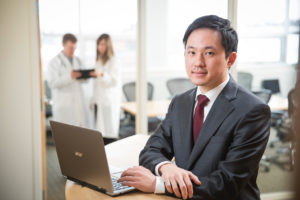A University of Calgary professor wants rural seniors to have an opportunity to remain at home for as long as they can.
Joon Lee along with a working group on the topic spent five years studying the influence that technology such as big data generation and artificial intelligence might have on seniors’ chances of living at home for as long as possible.
“Most people desire to stay active and remain socially connected as [they] age,” wrote Lee in the executive summary of the position paper entitled: AGE-WELL Position Paper on Mobile Technology and Data-Informed Approaches for Healthy Aging and Aging in Place.

-Photo supplied by Joon Lee
“However, physical and cognitive decline, often inherent in aging, can hinder our ability to stay engaged in the activities we value,” noted Lee, the associate professor of Health Data Science and director of the Data Intelligence for Health Lab at the Cumming School of Medicine.
Lee worked with the AGE-WELL (Aging Gracefully Across Environments Using Technology to Support Wellness, Engagement and Long Life) Network of Centres of Excellence to explore the existing research about what technology has to offer to support seniors’ independent living.
With 20 per cent of Canadians projected to be aged 65 years and older by 2030, Lee sees a need for more options in mobile technology to allow seniors to live independently for longer.
The full potential of [mobile] health in this field is not being realized, in part, because devices and apps are often not designed to compensate for the cognitive or physical impairments that can increase with age.
– Joon Lee, associate professor with the University of Calgary’s Cumming School of Medicine
According to Lee, the use of technology known as mobile health has the potential to be a valuable tool in monitoring frailty in rural seniors. It may help reduce the strain on health and social care systems in the future by allowing seniors to share information from their own home or be remotely monitored for falls or other health issues like dementia.
“If the technology works well then what’s going to happen is that older adults will be able to rely on their wearable devices and smartphones to monitor their frailty,” Lee explained.
“If something in the data is picked up as a sign of worsening frailty, then they will be notified, and probably their primary care physician will be notified as well.”

-Photo supplied by Joon Lee
While many seniors already use smart phones and watches for fitness activities, setting prescription reminders, and other health-related tasks, the devices aren’t always used to their fullest potential or can be tricky to operate.
“The full potential of [mobile] health in this field is not being realized, in part, because devices and apps are often not designed to compensate for the cognitive or physical impairments that can increase with age,” said Lee, noting that new products are often tested on younger people who are typically well-versed in the latest technology.
Therefore, it’s vital that the technology be tested by seniors and also be designed in a way that they can input the information themselves in the case of tracking a diet or setting up a medication schedule, he noted.
If the technology works well then what’s going to happen is that older adults will be able to rely on their wearable devices and smartphones to monitor their frailty. If something in the data is picked up as a sign of worsening frailty, then they will be notified, and probably their primary care physician will be notified as well.
– Joon Lee, on the opportunities of future technology
With seniors possibly making errors or not taking advantage of all the features available, incorrect or missing data could lead to risks for seniors. Lee recommends that a variety of stakeholders including caregivers, health-care providers, older adults, policy makers, and industry be involved in any future studies so that potential products reflect seniors’ needs and abilities.
“For the technology to reach its full potential, these concerns will need to be addressed so that the information gained from accurate monitoring can be used to develop … impactful interventions for healthy aging and aging in place.”
In the case of passive data where information is collected without the actions of the device user as in the case of heart rate, developers must consider privacy, trust, and data ownership issues.
Lee insists that, while his own studies in this field are based on comprehensive data collected from 10 to 40 older participants, further research is necessary.
He hopes that his information will serve as a starting point for others interested in taking the concept further.
A full version of the position paper is available here.
Banner photo: Photo by Senior Guidance
